Taipei Times: The main financial backers of the Taipei MRT are the Taipei City Government, the Ministry of Transportation and Communications and the Taipei County Government. How is it possible that these investors -- spending taxpayers money -- permitted the world's most expensive per kilometer transportation system to be built underground in a flood-prone mountain basin without flood insurance?
Lee Po-wen (李博文): We based the design on a 200-year flood standard. The flooding we saw on Sept 17 was supposed to happen only once every 200 years. So no one expected such terrible flooding would happen. Usually most buildings only use a 50 or 100-year flood standard.
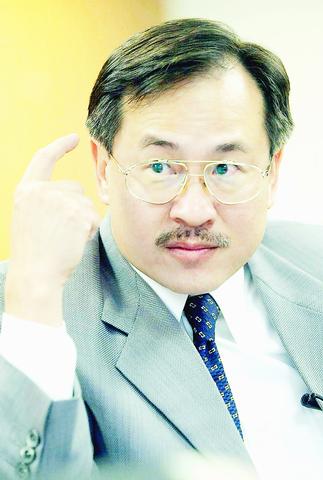
PHOTO: CHIANG YING-YING, TAIPEI TIMES
None of our backers required us to have flood insurance. Another reason insurance was not purchased is that flood insurance is kind of expensive. Many companies in Taipei don't use flood insurance. It was a cost consideration for us.
TT: How expensive is insurance and would it have been a practical investment in hindsight?
Lee: Flood insurance would cost roughly NT$100 million per year. That [type of expenditure] would affect operating costs. [Instead] what we are going to do now is upgrade our system to handle floods. We will install new flood gates at tunnels -- watertight gates.
TT: What is the current damage tally to date on the NT$450 billion MRT system from the floods?
Lee: According to our initial estimate, damage repairs and recovery of the entire MRT system will cost about NT$2 billion. But the actual total will depend on the results of equipment tests, supply bids and engineering services to be incurred. Damage to the Taipei Main Station alone is NT$400 million.
TT: Who is going to pay for the NT$2 billion in repairs?
Lee: We have asked the central government for help. There is also the [publicly-funded] Taipei MRT foundation that was set up solely for the MRT. The money used for repairs will not impact the expansion of planned MRT lines or those currently under construction. The [publicly-funded] Taipei City Government Reconstruction Council will also work to solve the perennial flood problem in Taipei once and for all and seek consultation and advice from experts and scholars.
TT: What happened on the morning of Sept .17 when the floods hit?
Lee: As you know, the typhoon stayed over Taiwan and dumped rain for two full days. On that morning we watched water pour into the MRT system at various locations like a waterfall. At the Kunyang Station water came in from the East, flooding the tracks and flowing down the tracks all the way to the Taipei Main Station. First it flowed into the top lower level, then into the second lower level. So of course we mobilized our people to sandbag YungChun Station since it is the high point in the line.
The water kept coming and there was no way to stop it. But that was not the only cause of the flooding in the Taipei main station. The main station has two lines flowing into it: the Pannan line and the Taiwan Railway tunnel to the above-ground Sungshan Train Station. Flood waters also flowed down that tunnel to the main station. They are on the second lower level and we are on the third lower level. Water flowed through to the third level, damaging the Tamshui line.
By 11:45am that morning the flood waters in the Kunyang Station had travelled into the main station and by 2pm water flowing down the Taiwan Railway line had also entered Taipei Main Station.
The key problem then was that the OCC [operations control center] is on the third lower level and the computer servers and power supply system are on the fourth lower level.
TT: What flood control measures, including water pumps and drainage systems, does the MRT system have?
Lee: The drainage design for stations aim to gather rainwater around entrances and ventilation openings, condensed water from air-conditioning systems, water on the floor and other general drainage before discharging to sump pits at two ends of the platform through the station drainage system. Every sump pit has three pumps -- installed at the low point in the tunnel -- which operate in turn according to the water level.
As for emergency flood protection, the TRTC has formulated an emergency response plan for the medium-capacity Mucha line and all high-capacity lines. The TRTC also conducts personnel training in flood protection, which covers flood-fighting equipment operations, maintenance and trouble-shooting. The equipment is checked before typhoon season and sandbags are prepared to fend off floods. An emergency management task force -- consisting of two rescue and repair groups -- formulates catastrophe scenarios and conducts simulation exercises including flood prevention drills. It also reviews exercise mistakes for future improvement.
But when the [Sept. 17] flooding occurred, we couldn't handle the water load, so we requested the city government bring in pumps to help. But the size of the pumps they brought in were too small, so it didn't help to counter the large volume of water. By late afternoon on Sept. 17 we decided we had lost the battle and retreated, taking OCC equipment with us.
TT: What equipment were you able to save and what was lost?
Lee: The majority of the OCC was saved. With that equipment we are now able to operate our temporary OCC -- the system the MRT has been running on since the floods. Actually we saved nine vehicles and about 70 percent of the computers and screens in Taipei Main Station. Those computers have been employed to restore signal, telecommunications, and other monitoring systems to reduce headway and enhance service quality.
We basically saved all moveable stock. The power supplies and cables were lost, but not the brains of the system. If we lost those computers, the whole rail system could have been shutdown for six months. Fortunately only two vehicles were submerged.
TT: How long did it take to pump out Taipei Main Station?
Lee: It took three days to pump out the third lower level. As for the fourth lower level, because the Tamshui Line was completely submerged it took another eight days to pump out. We did request the military step in to help us and they brought in more than 100 pumps, which ran 24 hours a day. The whole city was depending on us to get the system back on line.
TT: How did your team respond to the emergency?
Lee: We mobilized our entire emergency management task force and for the first few days we worked 24 hours day -- in rotating shifts to rescue the equipment. We did all we could.
We also received support from suppliers, contractors, the Taipei City Government, the Department of Rapid Transit Systems, the Taipei Department of Transport, Taipei Water Department, Taipei Fire Department, the central government, the military and other cities and counties. In the beginning we were all so shocked. Nothing like this had ever happened before. But as the rescue went on, team work took over and everyone pitched in. That's why we were able to get the system back up and running so quickly. I really appreciate the efforts of our staff.
TT: What is the timetable for getting the Taipei Main Station up and running again?
Lee: It will take six months to get the entire system back, including the OCC. Passengers can't tell the difference but we need to rebuild a permanent OCC. The system is currently running on automatic. Our priority is repairing the Pannan Line, with Hsinpu, Hsimen, Chunghsiao-Fuhsing and Kunyang as target points for resumed service in stages. As for the Taipei Main Station, we estimate a complete resumption of service at the end of December.
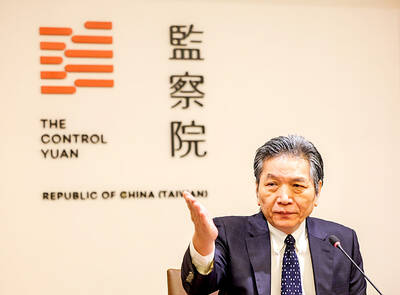
‘ABUSE OF POWER’: Lee Chun-yi allegedly used a Control Yuan vehicle to transport his dog to a pet grooming salon and take his wife to restaurants, media reports said Control Yuan Secretary-General Lee Chun-yi (李俊俋) resigned on Sunday night, admitting that he had misused a government vehicle, as reported by the media. Control Yuan Vice President Lee Hung-chun (李鴻鈞) yesterday apologized to the public over the issue. The watchdog body would follow up on similar accusations made by the Chinese Nationalist Party (KMT) and would investigate the alleged misuse of government vehicles by three other Control Yuan members: Su Li-chiung (蘇麗瓊), Lin Yu-jung (林郁容) and Wang Jung-chang (王榮璋), Lee Hung-chun said. Lee Chun-yi in a statement apologized for using a Control Yuan vehicle to transport his dog to a
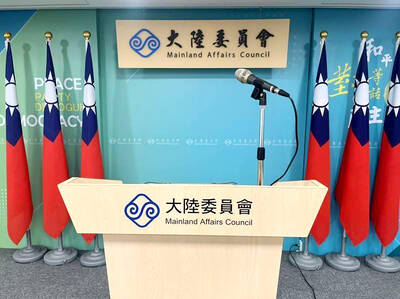
BEIJING’S ‘PAWN’: ‘We, as Chinese, should never forget our roots, history, culture,’ Want Want Holdings general manager Tsai Wang-ting said at a summit in China The Mainland Affairs Council (MAC) yesterday condemned Want Want China Times Media Group (旺旺中時媒體集團) for making comments at the Cross-Strait Chinese Culture Summit that it said have damaged Taiwan’s sovereignty, adding that it would investigate if the group had colluded with China in the matter and contravened cross-strait regulations. The council issued a statement after Want Want Holdings (旺旺集團有限公司) general manager Tsai Wang-ting (蔡旺庭), the third son of the group’s founder, Tsai Eng-meng (蔡衍明), said at the summit last week that the group originated in “Chinese Taiwan,” and has developed and prospered in “the motherland.” “We, as Chinese, should never
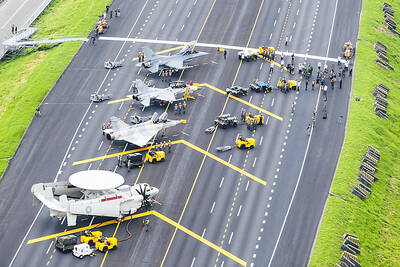
‘A SURVIVAL QUESTION’: US officials have been urging the opposition KMT and TPP not to block defense spending, especially the special defense budget, an official said The US plans to ramp up weapons sales to Taiwan to a level exceeding US President Donald Trump’s first term as part of an effort to deter China as it intensifies military pressure on the nation, two US officials said on condition of anonymity. If US arms sales do accelerate, it could ease worries about the extent of Trump’s commitment to Taiwan. It would also add new friction to the tense US-China relationship. The officials said they expect US approvals for weapons sales to Taiwan over the next four years to surpass those in Trump’s first term, with one of them saying
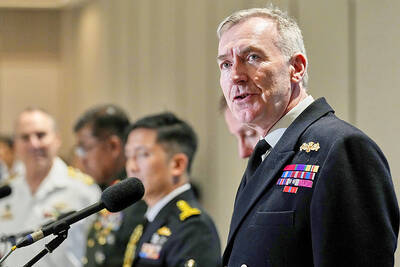
INDO-PACIFIC REGION: Royal Navy ships exercise the right of freedom of navigation, including in the Taiwan Strait and South China Sea, the UK’s Tony Radakin told a summit Freedom of navigation in the Indo-Pacific region is as important as it is in the English Channel, British Chief of the Defence Staff Admiral Tony Radakin said at a summit in Singapore on Saturday. The remark came as the British Royal Navy’s flagship aircraft carrier, the HMS Prince of Wales, is on an eight-month deployment to the Indo-Pacific region as head of an international carrier strike group. “Upholding the UN Convention on the Law of the Sea, and with it, the principles of the freedom of navigation, in this part of the world matters to us just as it matters in the